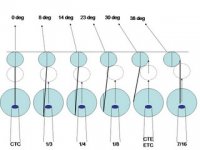Here is how I interpret CJ's aiming method.
The fractions on the CB and the resulting cut angles are from the left edge and are approximated for Power Point is just a cartoon and not CAD.
Some wiewers will get the idea and depending on your vision center the cut angles will vary from shooter to shooter. With time at the table, one can memorize the aim point on the CB that is aimed at the center or edge of the OB and the resuting cut angle.
The pic on the right is aimed at the right edge of the OB and the fraction is 3/8 and not 7/8 from the left edge - my mistake.
This is a great diagram and although the relationships are the same as I illustrated in volume 3 of my Ultimate Pool Secrets I like yours better....as it shows the less of the CB hitting the center, the more angle is produced....after you visually learn how this works it's time to start sensing it...I've always thought of it as "feeling the angle with my eyes".....Less is More, in other words, the less of the cue ball you connect to the center of the object ball the More the cut angle.....the same therefore goes for connecting to the edge of the OB...LESS IS MORE...it's easy to remember for your subconscious especially, it can deal with a hundred times more info than this

